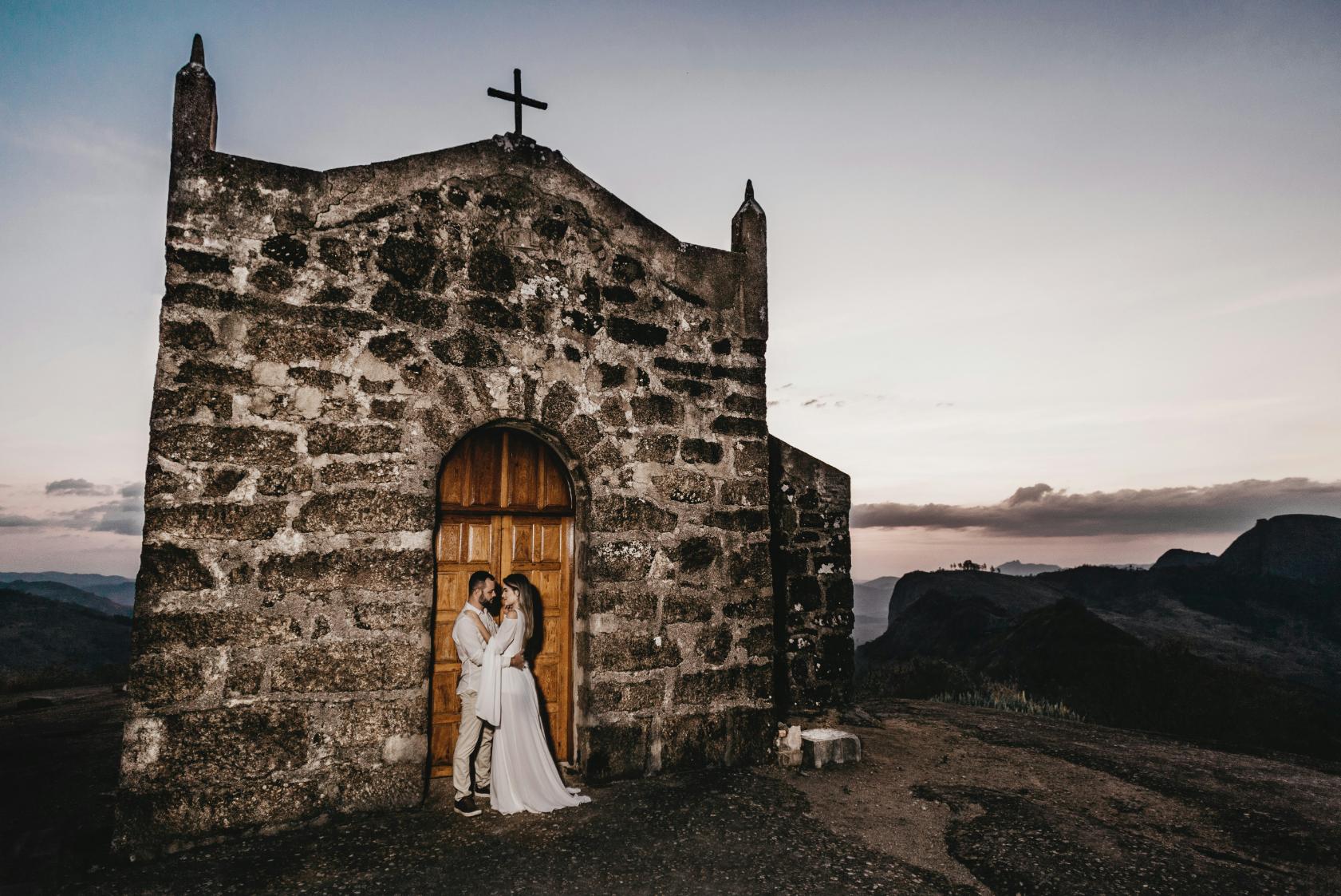
If you or your partner are Catholic and planning your wedding in Canada, you may be considering a Catholic wedding ceremony. Rooted in tradition and rich in rituals, Catholic weddings follow a structured format that has been cherished for centuries. They are not only elegant and deeply meaningful but also focus on the commitment you’re making to each other — and to God.
But what exactly happens during a Catholic wedding ceremony, and is it the right choice for you?
In this guide, we’ll walk you through some of the most common questions about Catholic weddings in Canada, including what they involve, how they unfold, and what costs to expect. With this information, you’ll be better equipped to decide whether a Catholic wedding aligns with your vision for your big day.
For more insights into different types of ceremonies, check out our Ultimate Wedding Ceremony Guide.
What is a Catholic wedding ceremony?
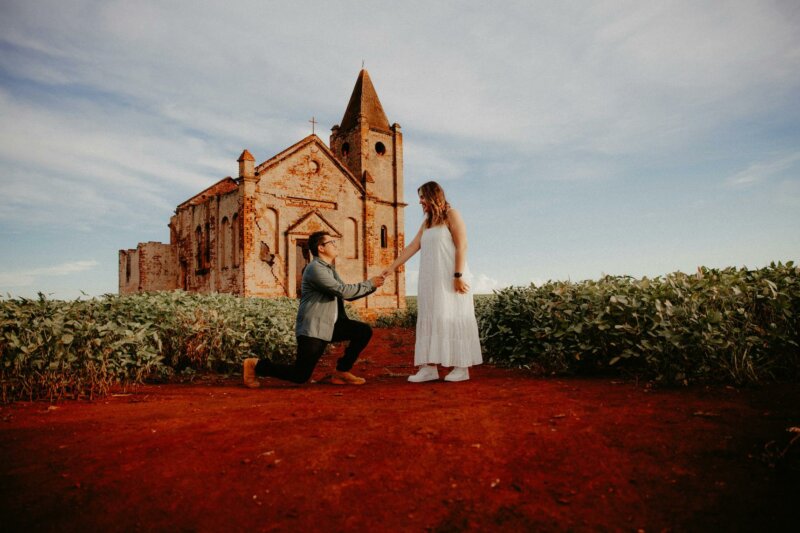
A Catholic wedding ceremony is a wedding ceremony that takes place in a church and follows a set structure. It may or may not include a nuptial mass, which is similar to a regular mass, only it takes place alongside the wedding. If you don’t want a nuptial mass at your ceremony, speak to the priest about this and discuss your hopes and expectations with them.
The ceremony will of course focus on your love and marriage, but there’ll also be a strong link to Christianity. That means there’ll be many references to God and Jesus, which may be in the words spoken by the officiant, and in the readings, hymns, blessings and prayers.
How soon can you have a Catholic wedding ceremony?

The Catholic Church asks that you give at least six months’ notice if you intend to get married in a Roman Catholic wedding ceremony.
What happens before a Catholic wedding ceremony?
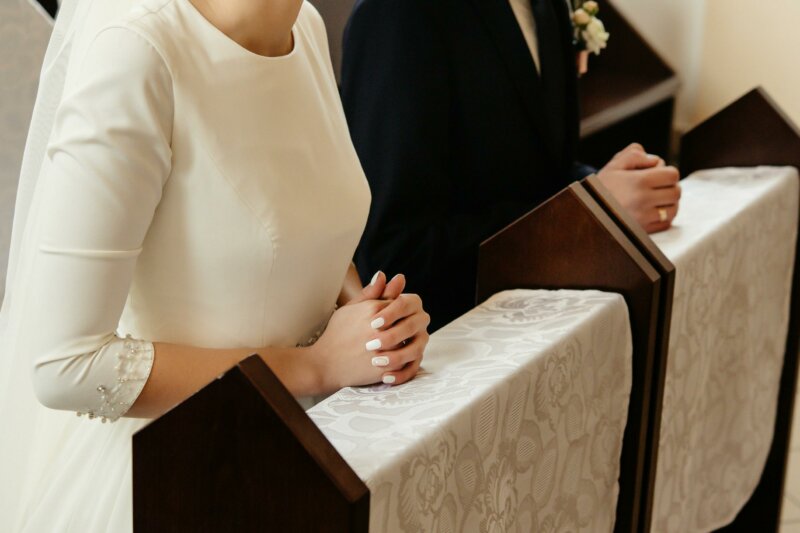
Many of the same traditions happen before a Catholic wedding in Canada as they do with other types of ceremonies — such as bachelor and bachelorette parties or the tradition of the couple not seeing each other before the wedding. However, one key difference with Catholic weddings is the requirement for a marriage preparation program designed to help couples build a strong foundation for married life.
This preparation, known as Pre-Cana, is a mandatory program that typically lasts six months. That’s why couples must give at least six months’ notice if they plan to marry in a Catholic church.
During Pre-Cana, couples learn about important aspects of marriage, including their relationship with God and the Church, shared values, financial management, responsibilities, parenting, intimacy, and more. If attending in-person sessions isn’t an option, online courses are available. Be sure to discuss with your priest whether an online format meets the requirements for your situation.
How popular are Catholic wedding ceremonies?
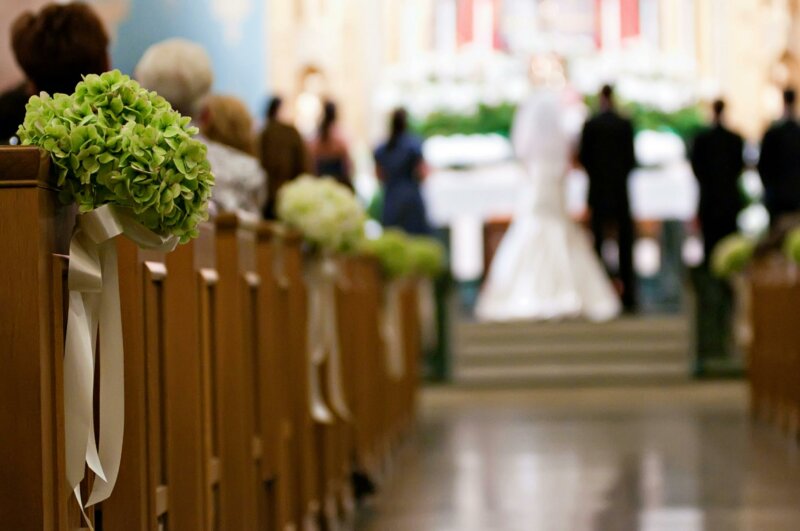
In Canada, the landscape of wedding ceremonies has evolved significantly over the years. As of 2023, only 24% of couples opted for religious wedding ceremonies, indicating a shift towards secular celebrations.
This trend is particularly evident in Quebec. In 2015, only 44% of the 22,400 marriages were conducted in churches, a significant decrease from 95.4% in 1971.
Overall, marriage rates in Canada have been declining. In 2020, 98,355 marriages were registered, the lowest annual number since 1938.
These statistics reflect a broader societal shift towards secularization and changing attitudes toward marriage in Canada.
What type of couples usually choose a Catholic wedding ceremony?
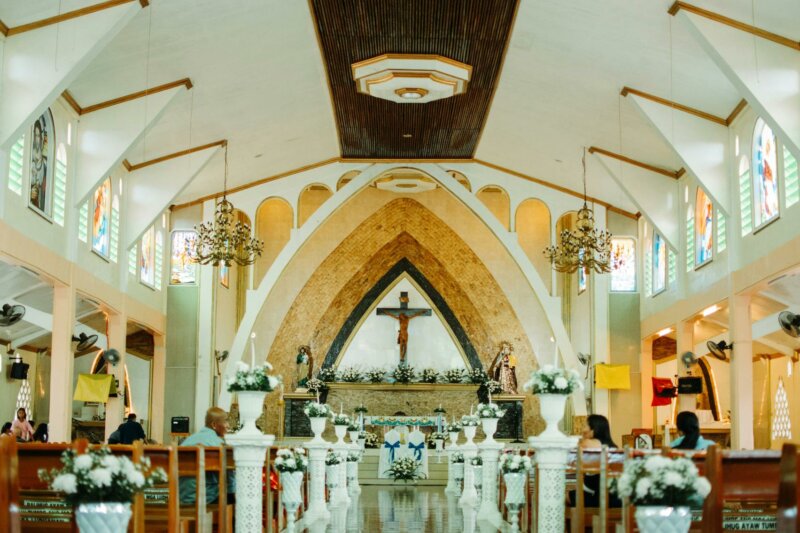
As you might expect, only Catholics get married in a Catholic wedding ceremony. However, both halves of the couple don’t need to be Catholic – to have a Catholic wedding ceremony, just one needs to be a member of the church. If you’re part of a mixed-faith relationship, it’s your choice whether you have a Catholic ceremony or you opt for something else.
Whether or not you choose to have a Catholic ceremony depends on your beliefs, preferences and budget.
Are Catholic weddings expensive?
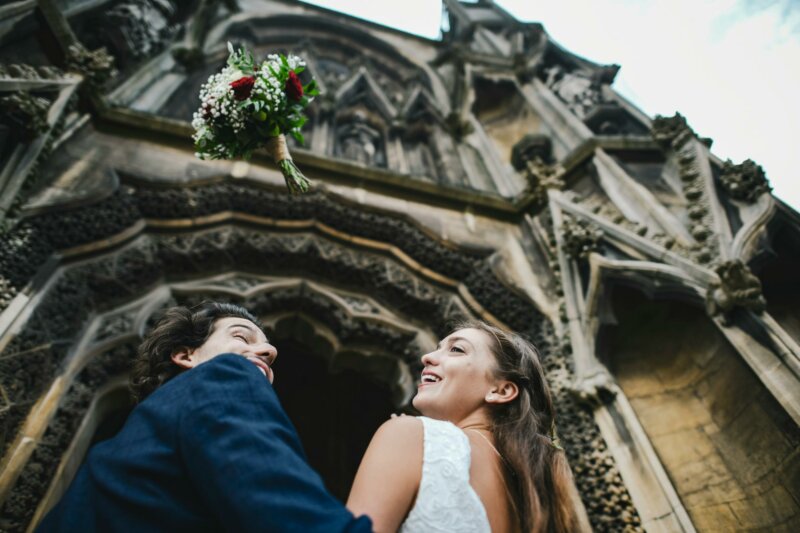
The average cost of a church wedding in Canada is between $300 and $1,500. However, this figure is the average cost of weddings that take place in any type of Christian church.
In Canada, while the Sacrament of Marriage itself is considered a gift from God and does not have a set fee, individual Catholic parishes typically request donations or have specific fees to support the maintenance of the church and its services. These contributions can vary significantly depending on the parish and its location. It’s important to note that these fees often encompass various services, including meetings with the priest, rehearsal time, and administrative costs. Additional expenses may include musician fees, marriage preparation courses, and marriage licenses. For instance, some parishes may charge around $300 for the marriage preparation course and certificate, and approximately $135 for the marriage license.
It’s also worth noting that there’s also an additional fee for any ‘extras’ you might like to have included at your ceremony. These, and their approximate costs, include:
- Organist – around $100–$300
- Bell ringing – around $50–$150
- Verger – around $50–$100
- Extra heating – around $75–$200
You’ll also need to factor in the cost of external vendors you might choose to hire, such as florists, decor, a photographer and videographer. In Canada, a Catholic priest or deacon typically serves as the authorised marriage celebrant, fulfilling both religious and legal roles during the wedding ceremony. Therefore, hiring an additional registrar is generally unnecessary. However, it’s essential to confirm this arrangement with your chosen church, as procedures can vary. Additionally, you are required to have two witnesses, each at least 18 years old, present at the ceremony to sign the marriage register.
If you plan on celebrating after the ceremony with a wedding breakfast and reception, this will of course come at a cost, as you can’t host this at the church.
Who officiates a Catholic wedding ceremony?
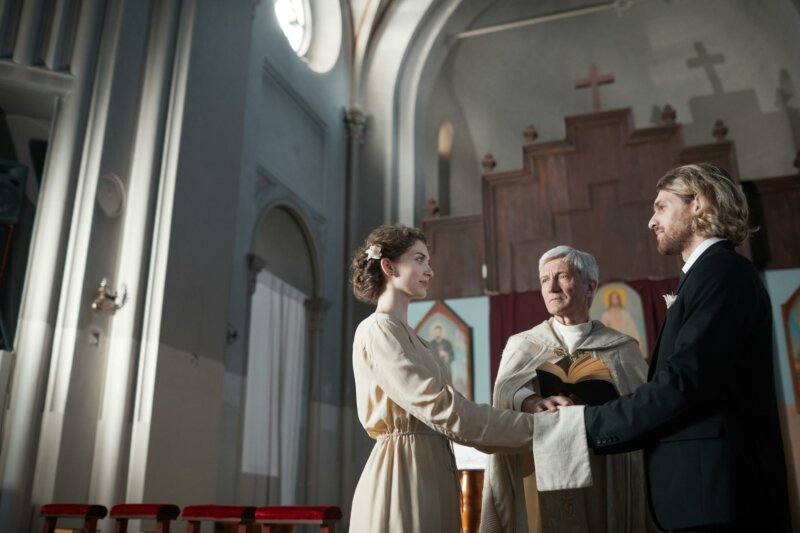
A Catholic wedding is usually officiated by a priest, or in some cases a deacon.
Is a Catholic wedding ceremony legally binding?
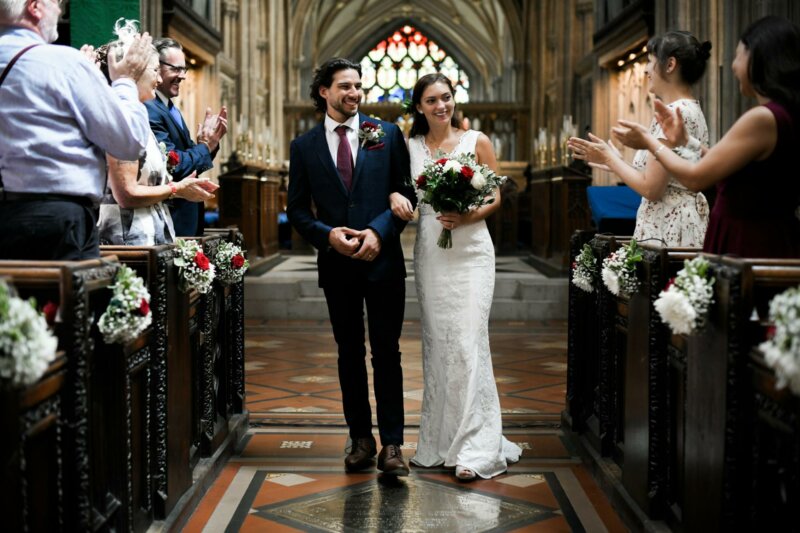
In Canada, a Catholic wedding ceremony can be legally binding without the need for a separate civil ceremony, provided that certain conditions are met. Catholic priests and deacons are generally authorized to officiate marriages that are recognized by both the Church and the state. To ensure the legality of the marriage, couples must obtain a civil marriage license prior to the ceremony. This license is typically presented to the officiating priest or deacon, who will complete and submit it to the appropriate government authorities following the ceremony.
It’s important to note that the specific requirements and procedures can vary by province. Therefore, it’s advisable to consult with your local parish and review provincial marriage laws to ensure all legal obligations are fulfilled. By adhering to these guidelines, a Catholic wedding ceremony serves as both a sacred religious rite and a legally recognized union.
Where are Catholic wedding ceremonies held?
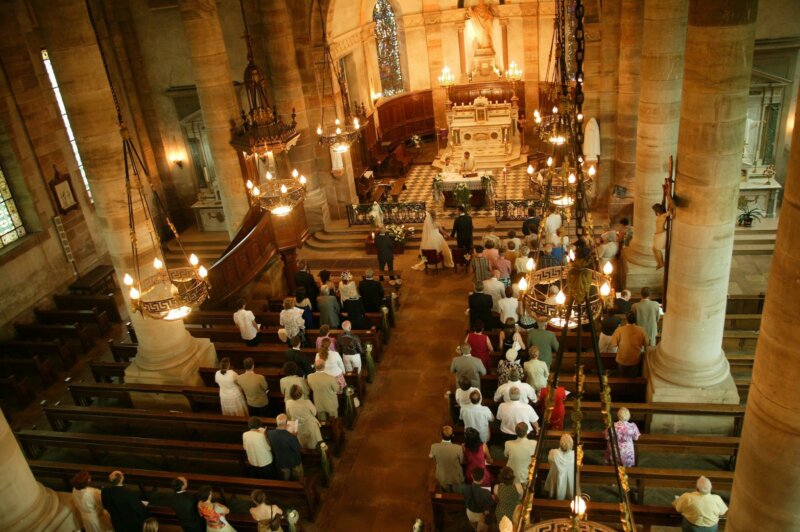
Catholic weddings are always held at a Catholic church. If you’re looking for greater flexibility and would like to get married elsewhere, you’ll have to consider having a different type of wedding ceremony.
How long are Catholic wedding ceremonies?
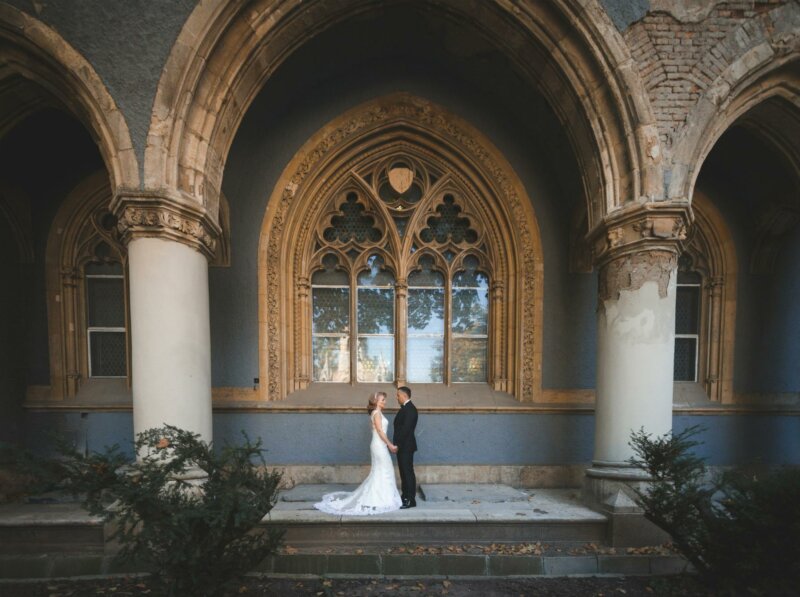
When you speak to your priest about your wedding, you should be given a choice about whether or not you’d like to include a mass at the same time as your ceremony. If you include a communion and mass, your wedding ceremony will take around an hour. If you don’t have a mass, your ceremony will take between 30 and 45 minutes.
Catholic weddings often last longer than traditional weddings due to the references to God and religion, with the addition of hymns, readings, blessings and prayers.
When does a Catholic wedding ceremony take place?
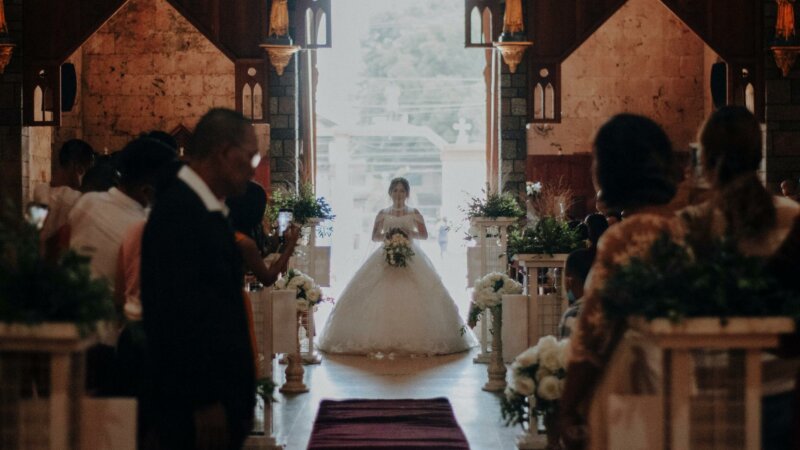
Catholic wedding ceremonies usually take place sometime after lunch, often between 1pm and 3pm. This is because there is often mass in the late afternoon or early evening.
Read our post on the best wedding day timeline for more information about what happens on a wedding day and when.
What words are exchanged at a Catholic wedding ceremony?
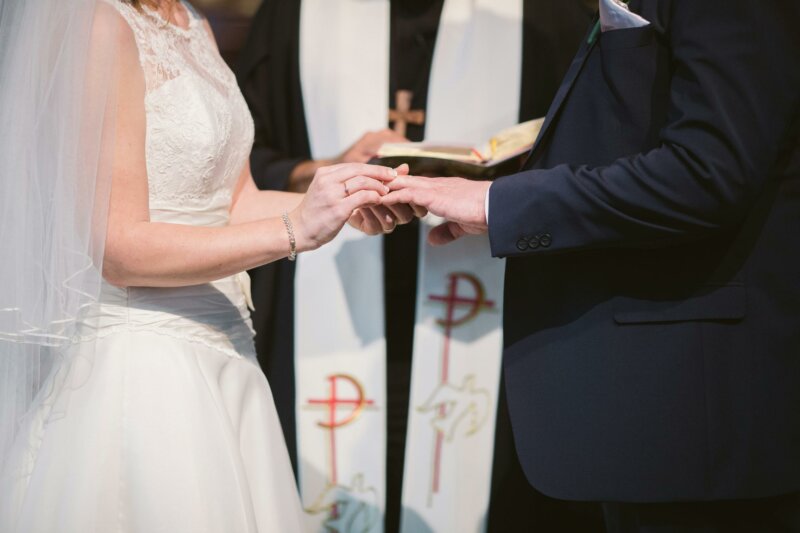
Many Roman Catholic wedding ceremonies follow a set structure, so the words spoken will often be reminiscent of other Catholic ceremonies you may have been to. Most of the words are spoken by the officiant, but you and your partner will also speak to exchange vows and consent to the marriage. These include
1. The address and statement of intention
The priest will ask whether you’ve come together to enter into marriage freely and without coercion, to which you’ll both respond by saying, ‘I have’.
The priest will then ask whether you’re both prepared to follow the path of marriage, to love and honor each other for as long as you both shall live. You’ll then respond by saying, ‘I am.’
2. Exchange of consent
The priest will then ask you to repeat the exchange of consent, which is as follows:
“I, [YOUR FULL NAME], take you, [YOUR PARTNER’S FULL NAME], to be my [WIFE/HUSBAND/PARTNER]. I promise to be faithful to you in good times and in bad, in sickness and in health, to love you and to honour you all the days of my life.”
3. Exchanging of the rings
As you exchange rings, you’ll also say the following words:
“[YOUR PARTNER’S FULL NAME], receive this ring as a sign of my love and fidelity. In the name of the Father, the Son and the Holy Spirit.”
Unfortunately, because Catholic ceremonies follow a program template, it’s unlikely that the priest will allow you to write or speak personal vows. If you would like a much greater amount of personalization at your wedding, you may have to plan a different type of ceremony.
What traditions are there at a Catholic wedding ceremony?
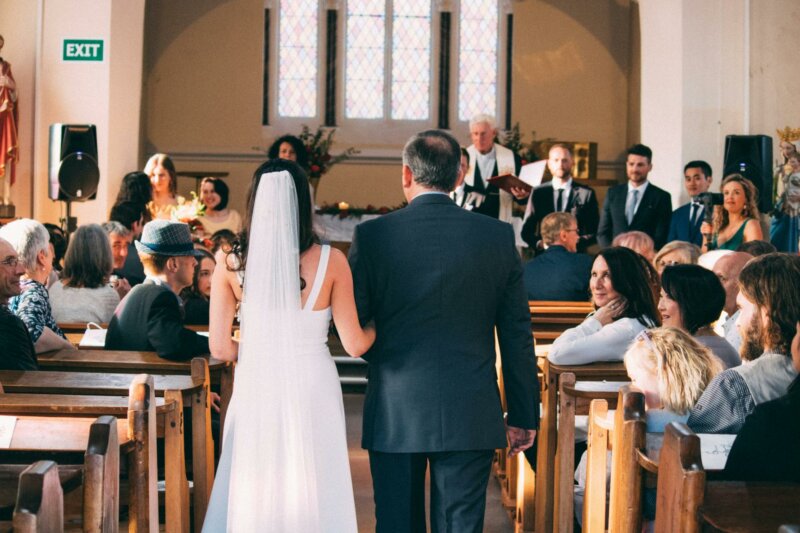
Because Catholic wedding ceremonies stick to a relatively strict structure, there are plenty of traditions that take place. Which traditions you choose to include in your own ceremony depends on your preferences and the flexibility of that structure. If there are any traditions you want to change, you can speak to the priest ahead of the ceremony. Some of the most popular Catholic wedding ceremony traditions include:
- The processional, which is a staple at many different ceremonies. However, unlike traditional ceremonies, the groom enters first but from the side, not down the aisle.
- The opening greeting and hymn, where the priest issues a greeting and invites your guests to sing a hymn, which is often Gloria.
- Nuptial mass, which many couples choose to include.
- Recitation of the Lord’s Prayer, shared as a unifying, sacred expression.
- Holy Communion, which symbolizes the spiritual unity of the couple and their journey together.
What do you wear at a Catholic wedding?
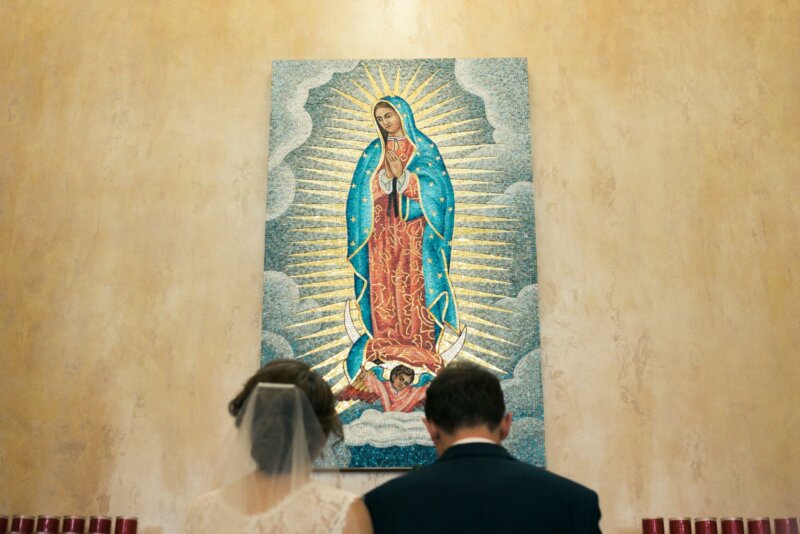
Catholic wedding ceremonies are semi-formal, so you don’t have to wear a tuxedo or dig out a hat. But, grooms will probably want to wear a suit, and brides a dress that’s relatively modest. The Church is becoming more open to sleeveless shirts and dresses, but aren’t quite as happy about plunging necklines or deep backs. Traditionally, the bride wears a veil, but this is also something the modern Church is more relaxed about.
What is the order at a Catholic wedding ceremony?
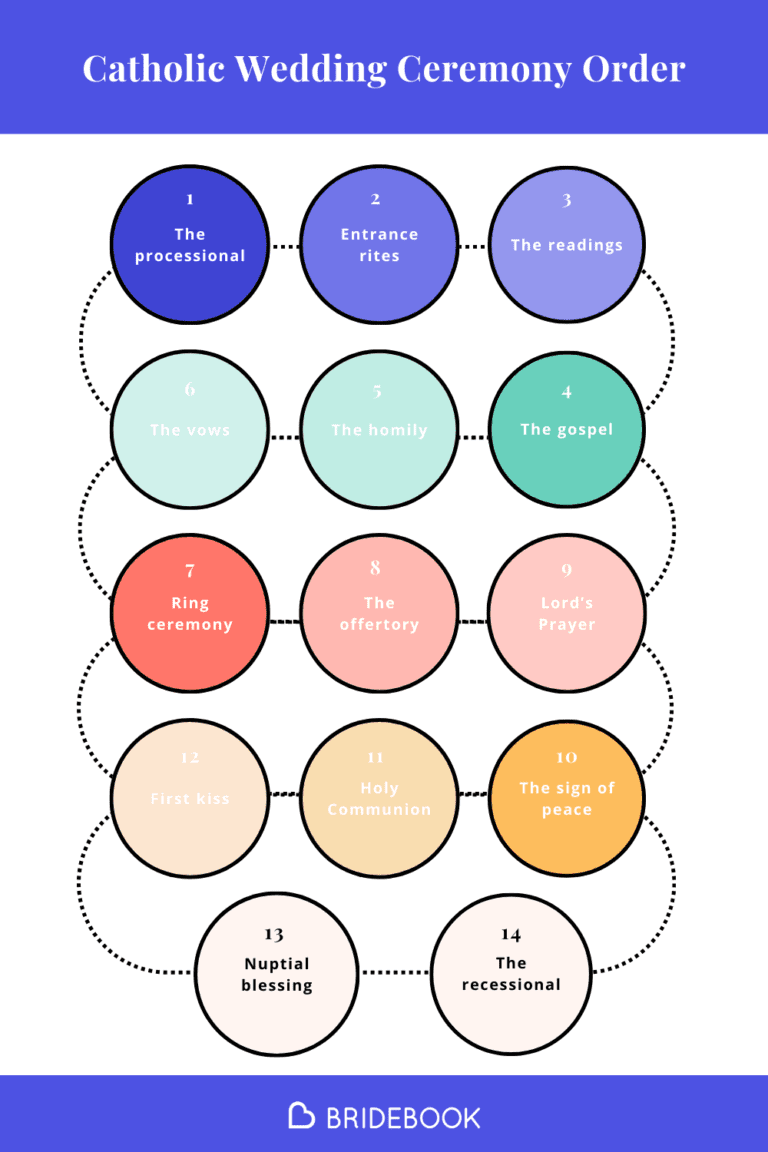
As we’ve already highlighted, Catholic weddings usually follow a set structure that will happen in a certain order. However, there will be a slight variation to this if you haven’t chosen to include a nuptial mass to take place alongside your wedding ceremony. Below is an example of what your Catholic wedding mass program might look like:
1. The processional
The processional begins with the priest entering from the side, followed by the groom and his best man. They stand at the altar, as the rest of the wedding party enter and walk down the aisle towards the altar in the following order:
- Bridesmaids
- Groomsmen
- Maid of honor
- Ring bearer or page boy
- Flower girl
- The bride and her father
2. The entrance rites
Once everyone has taken their seats, the priest begins by welcoming everyone to the ceremony and invites everyone to sing a hymn, usually Gloria, before reading a prayer. Because at least half of the couple has to be Catholic, it’s assumed that at least half of the guests will also be Catholic and therefore take part.
3. The readings
You can invite some of your guests to read Bible verses, which will usually include one from the New Testament and one from the Old Testament. The theme of the readings will be love, marriage or commitment. Your guests will repeat the Responsorial Psalm. There are seven to choose from, which you and your partner should consider during the lead-up to the ceremony.
4. The gospel
The priest will ask your guests to stand and they’ll read a passage from Matthew, Mark, Luke or John which will centre around love or marriage. Popular passages include Matthew 5:13-16, Mark 10: 6-9 and John 2:1-11.
5. The homily
The priest will perform a sermon, also known as the homily. This explains the meaning behind the gospel and how it applies to your marriage.
6. The vows
You will now be asked to say your vows, which are known as the rite of marriage. You can choose to recite them or read them, or the priest may read the vows so you can say I do. These are sacred and special words, which means you can’t write your own vows to use in a Catholic ceremony.
7. The ring ceremony
The priest will ask the best man for the rings, which they’ll first bless with holy water and by saying a prayer. You’ll then be asked to say a few more words as you place the ring on your partner’s finger.
8. The offertory
Some of your guests will now offer gifts, which they’ll do by bringing them to the altar. You’ll ask your guests to do this ahead of the ceremony, so it shouldn’t come as a surprise. For your other guests, a collection plate will be passed around the church so they can give a monetary donation.
At the same time, the priest will bless bread and wine, which is known as the Liturgy of the Eucharist.
9. The Lord’s Prayer
The congregation will recite The Lord’s Prayer in unison.
10. The sign of peace
The priest will ask everyone in attendance to greet each other with a warm welcome and handshake. This is a gesture of neighborly love.
11. Holy Communion
Your guests will line up at the altar for the priest to offer them bread and wine, something that symbolizes the body and blood of Jesus Christ.
12. The first kiss
The priest will invite the two of you to share your first kiss as a married couple. If the bride chooses to wear a veil, this is when the groom will lift it to see his wife’s face.
13. The nuptial blessing
The priest will say a final prayer which will end with the words, go in peace. Your guests will respond by saying, thanks be to God.
14. The recessional
The wedding party will leave the church in the opposite order to how they entered. Outside, you’ll take part in a photoshoot, including the wedding staple, the confetti shot.
For more information on the different orders at various ceremonies, read our guide to wedding ceremony orders.
How do you book a Catholic wedding ceremony?
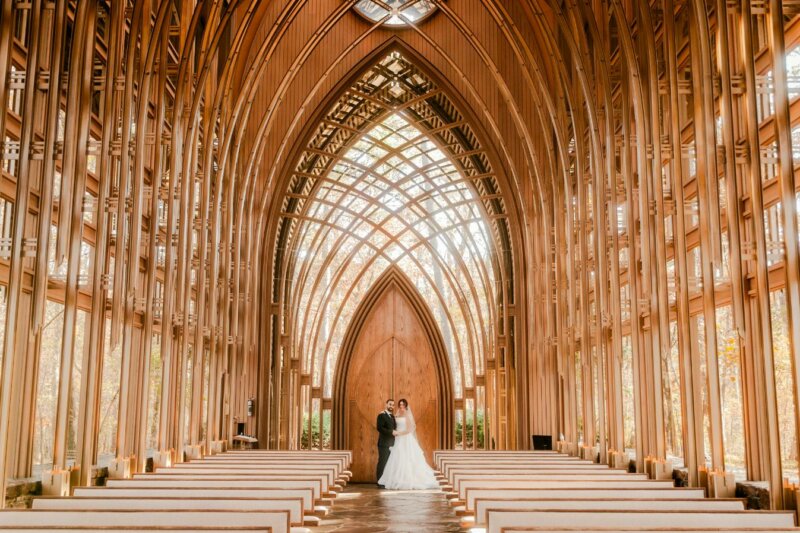
Once you’re engaged and have decided you’d like to have a Catholic wedding ceremony, the first thing to do is speak to the priest at your local Catholic church. The priest will then explain everything that needs to be done ahead of the wedding, such as the preparation program and paperwork. They should also be able to suggest a number of dates so you can begin planning the rest of your wedding.
Who plans a Catholic wedding ceremony?
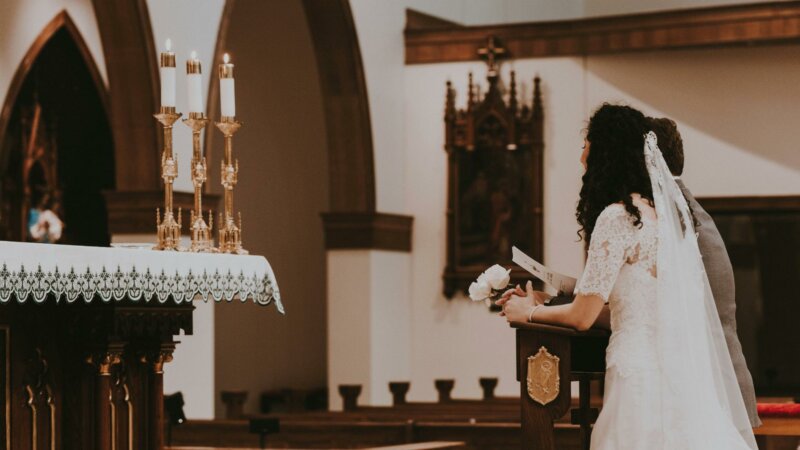
You can plan a Catholic wedding ceremony with the help of your priest. They should be able to advise you about what you want to include at the ceremony, including hymns, readings and any extras, such as an organist or bell ringer.
What comes after a Catholic wedding ceremony?
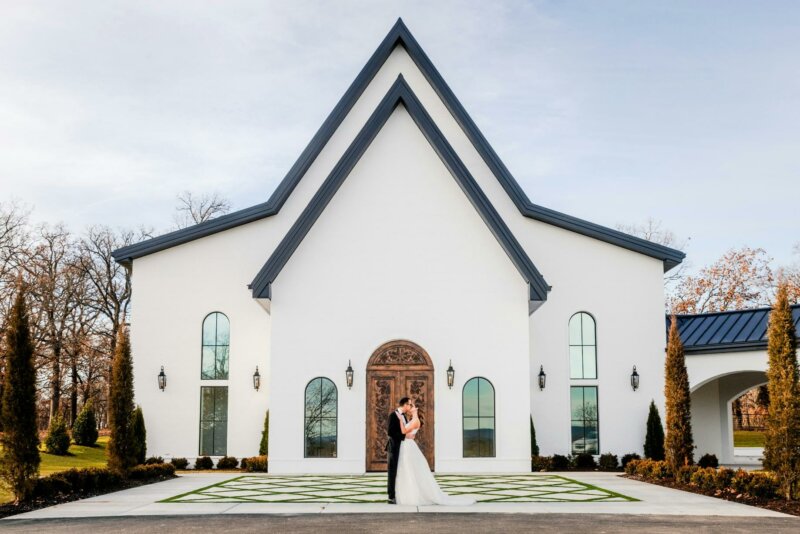
While Catholic wedding ceremonies follow a structured format with limited personalization, the reception is where you can truly showcase your creativity and style.
Many couples in Canada opt for a formal dinner with a multi-course meal, speeches, and drinks, followed by an evening celebration with music, dancing, and late-night snacks. Others prefer a more relaxed gathering or even an outdoor festival-style reception. Whether you go for an elegant ballroom affair, a rustic barn party, or a lively cultural celebration, your reception is an opportunity to make the day uniquely yours while staying within your budget and preferences.
Plan your wedding ceremony with Bridebook
Looking to plan your dream wedding? Sign up to Bridebook and get access to everything you need to organize your big day.
Browse other similar articles…
- How to Get Married: The Ultimate Step-By-Step Guide
- The Ultimate Wedding Ceremony Order
- The Best Wedding Day Timeline
- How Much Does a Church Wedding Cost in Canada
Happy Planning!

